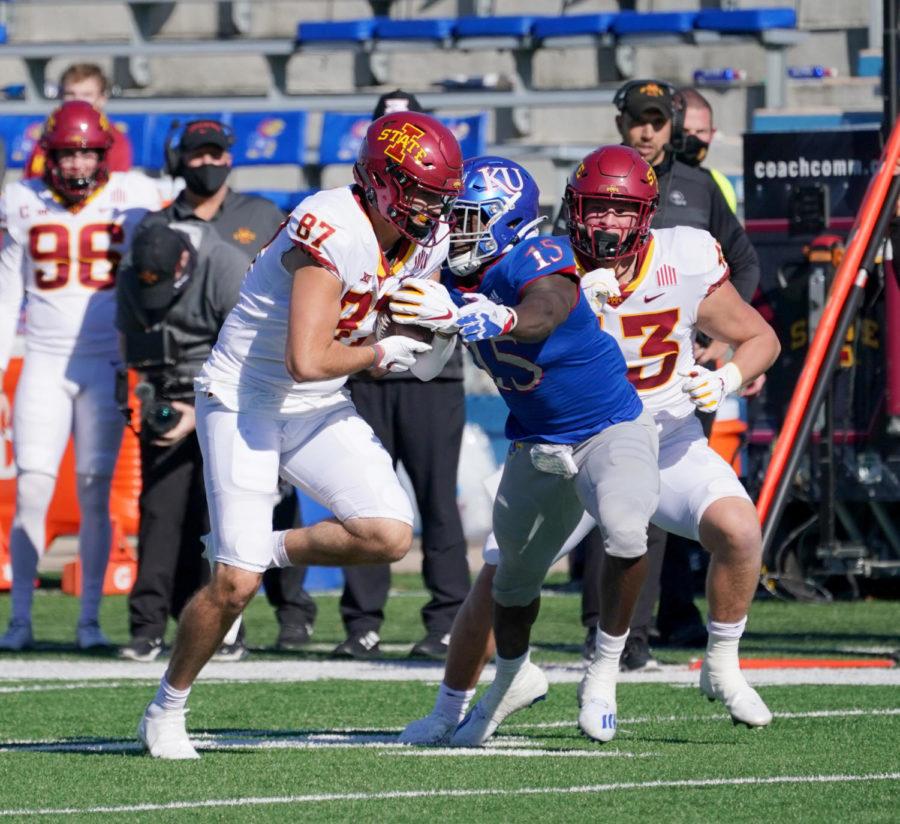Cyclones ‘mixing and matching’ potential tight end options during fall camp
August 12, 2021
Iowa State has had the luxury of having all the pieces to the puzzle at the tight end position over the last two seasons.
Charlie Kolar, Chase Allen and Dylan Soehner, among others, have all worked in tandem to turn a once glaring weakness for the Iowa State program into one of its most talked about strengths since 2018. But Soehner is gone, leaving behind 312 career receiving yards, praised interior blocking skills and a quiet but steady leadership presence.
As fall camp continues for the Cyclones, the search is on to find who can step up alongside Allen and Kolar and use their individual skills to give Iowa State the unique tight end looks it needs.
Iowa State head coach Matt Campbell told reporters at media day on Aug. 9 the focus in the tight end room is to evaluate each player for their own strengths and weaknesses and work to finding the best situations to give each player their best shot to be successful.
“There’s a lot of mixing and matching that I think we can do at the tight end position which is really good,” Campbell said.
Versatility is a trait Campbell and his staff aren’t taking lightly at any position battles this fall, but especially at tight end. And nobody has displayed that as much as redshirt junior Jared Rus.
“The first name for me is Jared Rus,” Campbell said. “You talk about a ‘glue guy’, losing some glue and I guy that kind of stepped in last year when Dylan [Soehner] went down and was really impressive to all of us and I guy that has taken some of those positive experiences at the end of this football and ran with it this offseason.
“Even in the first days of practice you’re like, ‘Geez, this guy looks fantastic.'” “He’s kind of like a fullback, but can he can play tight end and can do a lot of different things for our team.”
Rus is currently a walk on in the program, but is eager to show coaches and teammates what he can bring to the table as a third tight end option in the offense. Rus, a former high school running back, views himself as a hybrid of a traditional fullback, while also being able to go out and catch short passes when needed.
“I think right now everybody can play each position to be honest in the tight end room,” Rus said on Friday to reporters.
Mixing different names into the mix hasn’t bothered a veteran like Kolar during fall camp, but said it will be a challenge for anyone to replace Soehner — on and off the field.
“It’ll be hard to replace him, hard to replace the hairline too,” Kolar said of Soehner.
Kolar, a two-time First Team All-Big 12 tight end for the Cyclones (2019, 2020), returns for his senior season as one of Brock Purdy’s most trusted targets with 1,425 receiving yards and 17 career touchdowns to back it up. He learned with Soehner in the early stages of his Iowa State career.
Just as Campbell stated, no one is expected to become the next Dylan Soehner. But everyone is being asked to show their capabilities in some of his roles and whoever can use their abilities in more situations will likely be favored.
“I just think it’s trying to mismatch, mix and match and bring everybody in and use Chase’s talents, myself and whoever we have and just try to do the best we can to collectively do our job,” Kolar said.
Along with Rus, 6-foot-6 DeShawn Hanika, a redshirt sophomore, and true freshman Tyler Moore have been mentioned by Campbell throughout the spring and fall calendar. Not to mention, Easton Dean made his debut last season in multiple games, and caught his first career pass for a 25-yard reception.
Iowa State tight ends coach Taylor Mouser isn’t afraid to move names around, positions too, in order to find the best combination of talent for the Cyclones to work with come this fall.
And just because everyone can’t be a the receiving threats like Kolar and Allen are doesn’t mean they won’t find time on the field in valuable roles. Mouser’s got spots open.
“We’re always moving people around with who’s on the ball, who’s the off-the-ball guy, who’s the motion guy, who do we want on the front side, who do we want setting edges and things like that,” Mouser said.
“Right now it’s all about identifying who does those things good and not good and why it’s not good,” he said. “Doesn’t mean they can’t be the guy. We give everybody a chance to do all that stuff and figure out what they can do and what they can’t do and highlight the features and what they’re good and not good at.”







